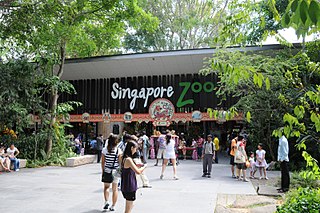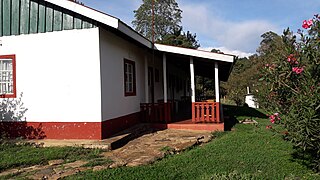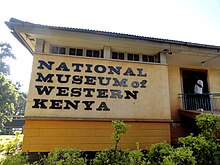
The Singapore Zoo, formerly known as the Singapore Zoological Gardens or Mandai Zoo, is a 28 hectares zoo located on the margins of Upper Seletar Reservoir within Singapore's heavily forested central catchment area. It is operated by the Mandai Wildlife Group, which also manages the neighbouring Night Safari, River Wonders, Bird Paradise as well as the forthcoming Rainforest Wild Park.

Mount Elgon is an extinct shield volcano on the border of Uganda and Kenya, north of Kisumu and west of Kitale. The mountain's highest point, named "Wagagai", is located entirely within Uganda. Although there is no verifiable evidence of its earliest volcanic activity, geologists estimate that Mount Elgon is at least 24 million years old, making it the oldest extinct volcano in East Africa. The mountain's name originates from its Maasai name, “Ol Doinyo Ilgoon”.

Kitale is a town in the north west of Kenya, in the old Rift Valley province. It situated between Mount Elgon and the Cherangany Hills.The town has an elevation of around 1,900 metres (6,200 ft) Its population was 162,174 as of 2019. Kitale town is the headquarter of the Trans-Nzoia County, which is also sometimes generally referred to by the name of the town. Kitale is reachable by air through Kitale Airport. The postal code for Kitale is 30200.

Trans-Nzoia County is a county in the former Rift Valley Province, Kenya, located between the Nzoia River and Mount Elgon, 380 km northwest of Nairobi. At its centre is the town of Kitale which is the capital and largest town. It is bordered by the Republic of Uganda to the west, Bungoma and Kakamega Counties to the south, West Pokot County to the east, and Elgeyo Marakwet and Uasin Gishu Counties to the southeast. Trans Nzoia covers an area of 2495.5 square kilometres. The county has a cool and temperate climate, with daytime temperatures ranging from 23.4°C to 29.2°C and nighttime temperatures from 11.0°C to 13.5°C. It receives moderate rainfall, making it suitable for agriculture

Nyeri is a town situated in the Central Highlands of Kenya. It is the county headquarters of Nyeri County. The town was the central administrative headquarters of the country's former Central Province. Following the dissolution of the former provinces by Kenya's new constitution on 26 August 2010, the city is situated about 150 km north of Kenya's capital Nairobi, in the country's densely populated and fertile Central Highlands, lying between the eastern base of the Aberdare (Nyandarua) Range, which forms part of the eastern end of the Great Rift Valley, and the western slopes of Mount Kenya.

Cherokee is a census-designated place (CDP) in Swain and Jackson counties in Western North Carolina, United States, within the Qualla Boundary land trust. Cherokee is located in the Oconaluftee River Valley around the intersection of U.S. Routes 19 and 441. As of the 2020 census, the CDP had a population of 2,195. It is the capital of the federally recognized Eastern Band of Cherokee Indians, one of three recognized Cherokee tribes and the only one in North Carolina.

The Australian National Botanic Gardens (ANBG) is a heritage-listed botanical garden located in Acton, Canberra, in the Australian Capital Territory, Australia. Established in 1949, the Gardens is administered by the Australian Government's Department of Agriculture, Water and the Environment. The botanic gardens was added to the Commonwealth Heritage List on 22 June 2004.

The Los Angeles Zoo and Botanical Gardens is a 133-acre (54 ha) zoo founded in 1966 and located in Los Angeles, California, United States. The city of Los Angeles owns the zoo, its land and facilities, and the animals.

Topanga State Park is a California state park located in the Santa Monica Mountains, within Los Angeles County, California. It is part of the Santa Monica Mountains National Recreation Area.

Michael Christopher Kijana Wamalwa was a renowned Kenyan politician who at the time of his death was serving as the eighth Vice-President of Kenya.

Kapenguria is a town in Kenya. It is the capital and largest urban center of West Pokot County. The town lies north east of Kitale on the A1 road along Kitale-Lodwar road in north Western Kenya. Kapenguria forms a municipality with a population of 40,751 as per the 2019 Kenya Population and Housing Census.

Echis is a genus of vipers found in the dry regions of Africa, the Middle East, India, Sri Lanka and Pakistan. They have a characteristic threat display, rubbing sections of their body together to produce a "sizzling" warning sound. The name Echis is the Latin transliteration of the Greek word for "viper" (ἔχις). Like all vipers, they are venomous. Their common name is "saw-scaled vipers" and they include some of the species responsible for causing the most snakebite cases and deaths in the world. Twelve species are currently recognized.

The National Museums of Kenya is a state corporation that manages museums, sites and monuments in Kenya. It carries out heritage research, and has expertise in subjects ranging from palaeontology, archeology, ethnography and biodiversity research and conservation. Its headquarters and the National Museum are located on Museum Hill, near Uhuru Highway between Central Business District and Westlands in Nairobi. The National Museum of Kenya was founded by the East Africa Natural History Society (E.A.N.H.S.) in 1910; the society's main goal has always been to conduct an ongoing critical scientific examination of the natural attributes of the East African habitat. The museum houses collections, and temporary and permanent exhibits. Today the National Museum of Kenya manages over 22 regional museums, many sites, and monuments across the country.

Turkana County is a county in the former Rift Valley Province of Kenya. It is Kenya's second largest county by land area of 98,597.8km2 followed by Marsabit County with an area of 71,597.8km2. It is bordered by the countries of Uganda to the west; South Sudan and Ethiopia, including the disputed Ilemi Triangle, to the north and northeast; and Lake Turkana to the east. To the south and east, neighbouring counties in Kenya are West Pokot, Baringo and Samburu Counties, while Marsabit County is on the opposite shore of Lake Turkana. Turkana's capital and largest town is Lodwar. The county had a population of 926,976 at the 2019 census.

The Stamford Museum & Nature Center, located in Stamford, Connecticut, is an art, history, nature, and agricultural sciences museum. The property covers 118 acres beginning about half a mile north of the Merritt Parkway. It was originally a private estate.
Lieutenant-Colonel Thomas Herbert Elliot Jackson was an English coffee farmer in Kenya. He served as an officer in the British Army during the Second World War, seeing service with the King's African Rifles and as a military administrator in British Somaliland. Jackson served in the Kenyan colonial administration during the Mau Mau Rebellion.

Western Sydney Regional Park is a large urban park and a nature reserve situated in Western Sydney, Australia within the suburbs of Horsley Park and Abbotsbury. A precinct of Western Sydney Parklands, a park system, and situated within the heart of the Cumberland Plain Woodland, the regional park features several picnic areas, recreational facilities, equestrian trails, and walking paths within the Australian bush.
Birdsacre Sanctuary, also known as Stanwood Wildlife Sanctuary, is an historic house museum and wildlife sanctuary at 289 High Street in Ellsworth, Maine, United States. The core of the property is a 40-acre (16 ha) parcel owned by the pioneering Maine ornithologist Cordelia Stanwood, whose home was opened as a museum in 1960, and is listed on the National Register of Historic Places in 1973. Stanwood's homestead was extensively damaged by an arsonist-set fire in 2014. The sanctuary, now 200 acres (81 ha), includes trails, an orchard, and a nature center that showcases a fine art and nature collection, including Cordelia J. Stanwood's avian field-notes and extensive photographic collection.

Thimlich Ohinga is a complex of stone-built ruins in Migori county, Nyanza Kenya, in East Africa. It is the largest one of 138 sites containing 521 stone structures that were built around the Lake Victoria region in Kenya. These sites are highly clustered. The main enclosure of Thimlich Ohinga has walls that are 1–3 m (3.3–9.8 ft) in thickness, and 1–4.2 m (3.3–13.8 ft) in height. The structures were built from undressed blocks, rocks, and stones set in place without mortar. The densely packed stones interlock. The site is believed to date to the 15th century or earlier.
The Anglican dioceses of Nakuru are the Anglican presence in and around Nakuru, west-central, north-east and south-central Kenya; they are part of the Anglican Church of Kenya. The remaining dioceses of the Church area in the areas of Mombasa, of Maseno, and of Mount Kenya.


















